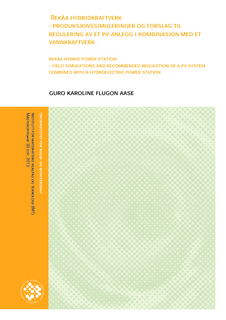| dc.description.abstract | Stor internasjonal vekst i solcellebransjen og synkende modul- og systempriser motiverer
Tinfos til å vurdere bygging av PV-anlegg i kombinasjon med eksisterende småkraftverk i
Rekåa. I oppgaven vurderes noen tekniske aspekter ved design av PV-anlegget samt
produksjon ved hjelp av simuleringsprogrammet PVsyst. Oppgaven presenterer også forslag
til regulering av hybridkraftverket.
Lokale måledata brukes for å fastsette nødvendige parametere, og simuleringene utføres med
databasene Meteonorm, PVGiS, NASA-SSE og Satel-Light. I simuleringene sammenlignes
monokrystallinsk modul fra Suntech, multikrystallinsk modul fra REC, modul laget av CIS
fra Solar Frontier og modul laget av kadmiumtellurid fra First Solar.
Vekselrettervalget viser seg å være komplisert da eksisterende transformator har
primærspenning på 690 V som ikke er en standard utgangsspenning blant leverandører av
vekselrettere. Oppgaven presenterer fire ulike løsninger. Vekselretter fra Eltek Valere
benyttes i simuleringene.
Regulering som baserer seg på måling av oljetemperaturen i transformatoren anbefales.
Temperaturen registreres av en PLS som sender signal til PV-anlegget om å koble inn eller ut
deler av PV-anlegget ettersom transformatorolja når ulike temperaturnivåer. Transformatoren
tåler en viss grad overlast i perioder, avhengig av temperaturen i viklingene. Det er derimot
vanskelig å si noe konkret om tidskonstant og temperaturutvikling ved ulik belastning, da
dette avhenger av mange variabler. Større og mer funksjonell vifte i transformatorrommet er
anbefalt for bedre kjøling av transformatoren.
Det er stor variasjon i innstrålingsdata fra databasene som er brukt i simuleringene. Dette
medfører usikkerhet i produksjonsestimatene. Ved helhetsvurdering anbefales
multikrystallinske moduler fra REC, selv om modulene av CIS overraskende viser høyest
årsproduksjon. Simuleringene tilsier at PV-anlegget vil produsere 0,43 GWh årlig dersom
transformatoren har tilstrekkelig kapasitet. Dette øker årsproduksjonen i Rekåa med 24 % til
2,2 GWh totalt. Ved å utvide Rekåa kraftverk med PV-anlegget utnyttes transformatoren og
nettilknytningen i større grad enn i dag. Total produksjonskurve blir noe jevnere, men
domineres fortsatt av høy produksjon på våren ved vårløsning og lav vinterproduksjon. The worldwide market for solar electric systems is increasing, and the cost of both modules
and PV-systems are decreasing. This motivates Tinfos to consider building a PV system
combined with one of their small hydroelectric power stations, located in Rekåa. This thesis
evaluates some technical aspects and yield simulations in the software PVsyst. It also presents
a possible regulation system for the hybrid power plant.
Data from local weather stations is collected to set some parameters for the simulations, and
the databases Meteonorm, PVGiS, NASA-SSE and Satel-Light are used in the simulations. A
mono crystalline module from Suntech, a multi crystalline module from REC, a module made
of CIS from Solar Frontier and a module made of Cadmium Telluride are compared.
Choosing an inverter turned out to be complicated due to the primary voltage of the
transformer at 690 V. This is not a standard output voltage for inverters. Four different
solutions are presented in this thesis, and an inverter from Eltek Valere is used in the
simulations.
A regulation based on measurements of the oil temperature is recommended. A PLS can
register the temperature, and instruct the PV system to deliver more or less power depending
on the temperature levels. The transformer can handle overload to some extent, but it is not
easy to estimate how it will cope with different overloads and the duration of these. It depends
on the temperature inside the transformer, and this is affected by several factors. Better
ventilation in the transformer room is highly recommended.
There is a great deal of uncertainty in the simulated production because of different irradiation
values in the meterological databases. The module from REC is recommended from a total
consideration, but the modules of CIS gave the highest total energy production in the
simulation results. The PV system produces 0,43 GWh a year if not limited by the transformer
capasity. This increases the yearly production in Rekåa with 24 %, to a total of 2,2 GWh a
year. By adding the PV system to Rekåa, the grid connection and the transformer will be
utilized better than today. The total production will still be relatively low during the winter
and high in the spring, but over all it gets slightly more evened out by the contribution from
the PV system. | no_NO |
